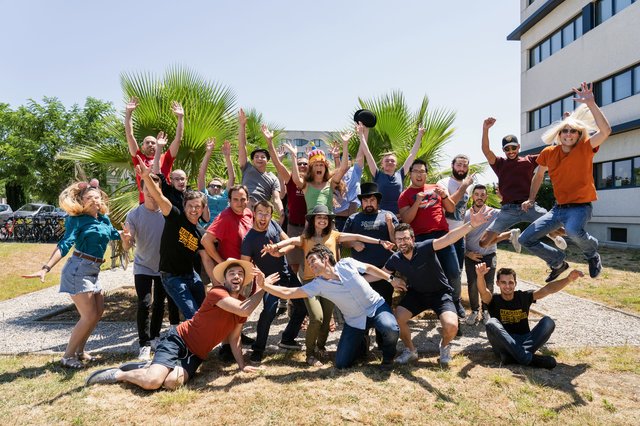There’s no Cupid in tech hiring. If you want to attract the best tech talent, you’re going to have to take things into your own hands – and it’s not easy.
For starters, it’s pretty slim pickings. Few developers are actively looking for a job. In fact, over 9000 developers took part in our recent survey and only 6.4% of them said they were currently unemployed and looking for employment.
What’s more, the majority of those who do have a job, are happy with their lot. 80.9% of our developer panel told us that they enjoy their job, answering between 6 and 10 to the question “On a scale of 0 to 10, do you enjoy your current job?”.
However, there’s hope! Despite being happy in their jobs, developers have rather itchy feet. 55.6% say that they tend to stay in the same job for less than three years. Why? Our panel of developers stated a higher salary (60.3%), better advancement opportunities (48.9%), or simply a change of scenery (38.9%) as the top three reasons they’d change work.

The dynamics of the tech recruitment market mean that you’re in with a chance: tech employees move around – but there’s a catch! Even if you have the full employer package, if you’re invisible to developers or if you have an iffy employer reputation, you will end up alone regardless. That’s where your employer brand comes in.
Here’s how to spice up your employer branding strategy and become irresistible to tech talent ❤️
Turn to your employer network: real-life and virtual
Your employer brand is the way your company is seen as an employer. Employer branding, then, is the promotion and marketing of your company as a place to work.
Where should you concentrate your promotion efforts? Where can you find tech talent, potentially on the lookout for a new employer?
73.4% of our developer panel said they’d turn to LinkedIn to look for a job opportunity and 46.9% said they’d turn to their friends, family and connections.
Thus, it’s definitely a good idea to make LinkedIn part of your employer branding efforts: the possibilities are endless. Start by building up your free company page. According to LinkedIn, this is where 59% of job seekers will go after hearing about a job opportunity. Make sure all the information is accurate and up to date, share company updates and content relevant to your activity or industry. If you spend time building up your LinkedIn “vitrine”, you’ll improve your visibility as a hiring organization to potential candidates.

Personal “real-life” networks are also important. To start with, make sure you turn to your own people. As in any other industry, a lot of developers know other developers, be it from school, from shared interests, from family connections, etc. You can expand your network be leaning on your current employees and encouraging them to communicate any employer branding efforts or tech job openings with their network. Did they share that video of your last team get together on social media? Did they send that job opening to their friend’s friend they told you about? Make it simple for them and, if they genuinely value you as an employer and think your company is a nice place to work, they will probably be more than happy to help.
You can also expand your “real-life” network and get a little closer to your next developer employee by attending or organizing events. A Hackathon or a coding contest is a great way to attract tech talent, build a strong employer brand and market your company as a “tech-friendly” place to work.
Cherry on the cake: your “virtual” and “real-life” employer networking efforts complement each other. It might sound obvious, but make sure to add anybody you meet at live events on LinkedIn.
Turn to your company blog
70% of developers say they like to read tech blogs to keep up with tech news.
Although this may not be the solution for small recruiting volumes, if you need to recruit large volumes of developers it’s worth investing in content. A blog is a great way to cultivate your company employer brand.
Make yourself known to tech talent, give them content to munch on and let them know what it’s like to work within your tech teams. You’ll create your own audience of developers, who might just think of you the next time they want to change jobs! You can also use your blog to promote any job openings.
Uber, for example, run their own engineering blog: Uber Engineering. Tech fans can browse categories such as AI, Architecture, Backend, Culture, Events, Open Source, Mobile, etc. There’s a good mix of tech trends, business news, and employer branding.
This article, for example, published last week, highlights the tech employees at Uber’s New York City office. Employees share their experience and give readers around the world a sneak peek at the Uber way of work. At the end of the article, the reader is invited to attend an Uber meetup or discover open tech positions on Uber’s career site.
“With life-size Jenga waiting to be played in the cafeteria, 40-inch balloons celebrating “Uberversaries,” and kombucha on tap, life certainly doesn’t get boring in the Uber office.”
Whether you choose to set up a specific engineering blog like Uber, or whether you stick to a company-wide corporate blog and use categories to showcase your tech subjects, blogs are definitely a good idea.
An offer tech talent can’t resist
Obviously, it’s not just about where you say it, it’s about what you say – and what you have to offer as an employer.
To build an effective employer brand, you need to know what’s important to developers. Once you know what matters to tech candidates, you can shine light on how that translates in your company. You need to know which heart strings to pull.
We asked developers what matters most to them when looking for a job opportunity. “A good work/life balance” (66.2%) and “company culture and values” (46.1%) were both stated in the top 5.
Defining your company values and including them in your employer branding strategy can make all the difference to job seekers. There are many different channels you can use to communicate your company culture and values (your blog, social media, career page, review sites, job boards, etc.). Key values, for example, makes it easy for developers to connect with employers who share the same values. Developers can select what matters most to them (“Impressive Team Members”, “Ideal for Parents”, “Data-Driven”, “Flexible Work Arrangements” or even “Has Good Beer”!) and find an employer they will click with.
What’s more, a huge 70.2% of developers prefer to work as part of a team. So, make sure your company’s team culture, in particular, shines through in your employer branding. Share videos and pictures of your last team outing, your last coding contest, or your last Wii tournament! When creating your job descriptions, make sure to underline team dynamics.

For 48.6% of developers “Passionate and/or technically brilliant colleagues” is the first thing they look for in a job opportunity. Showcase your existing employees in interviews or articles. Make it easy for developers to imagine slotting into your brilliant tech team.
Developers also value organization and clear directions. 44.8% of our developer panel stated “a clearer roadmap” as the main thing that would make them happier at work. So, reassure developers on your internal processes.
Spotify, for example, released a two-part video describing their internal tech process. They were completely transparent and describe the video as “somewhere between “How Things Are Today” and “How We Want Things To Be”. Totally honest and a little creative, Spotify’s video became a reference in terms of tech team organization – and you can bet they received a good bunch of applications from tech talent who identified with their way of working and who wanted to be a part of it.
Now you know a little more about what developers want and where to find them, you’re set to start building or improving engagement with your employer brand! You will be irresistible in no time.


